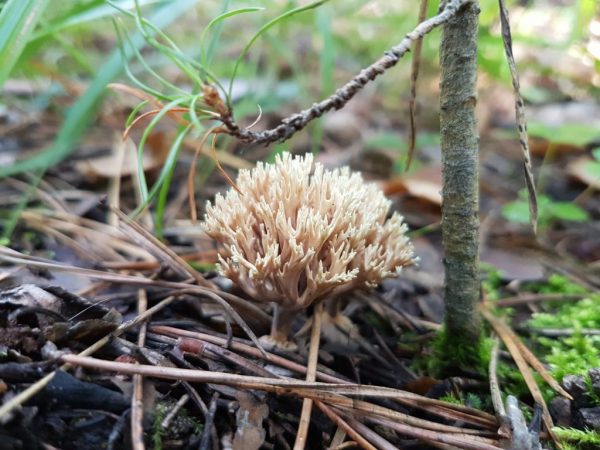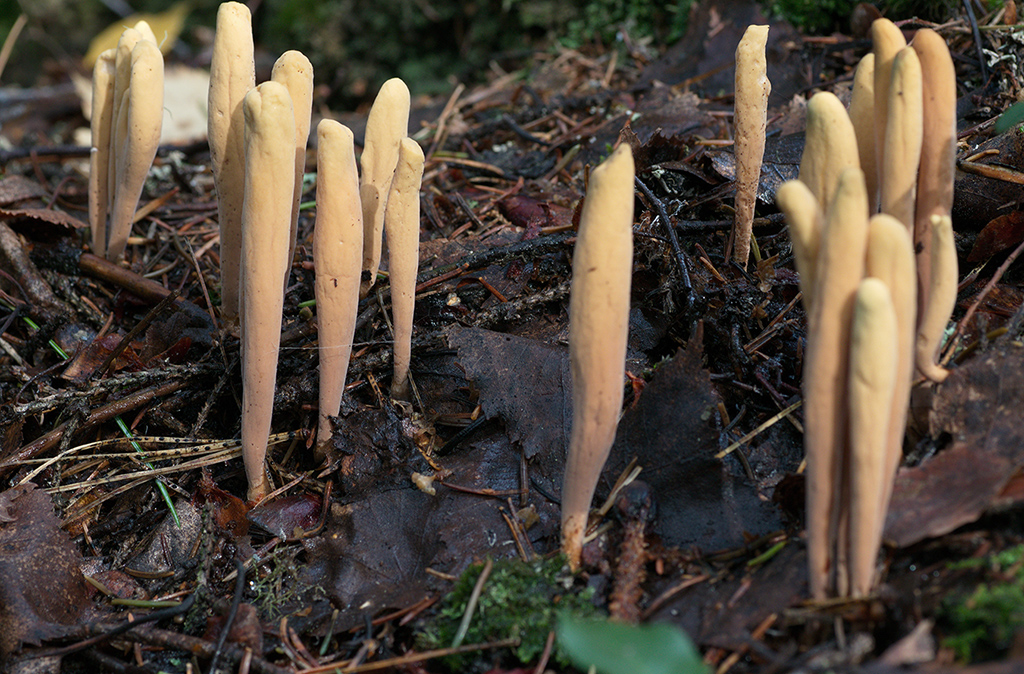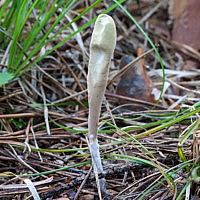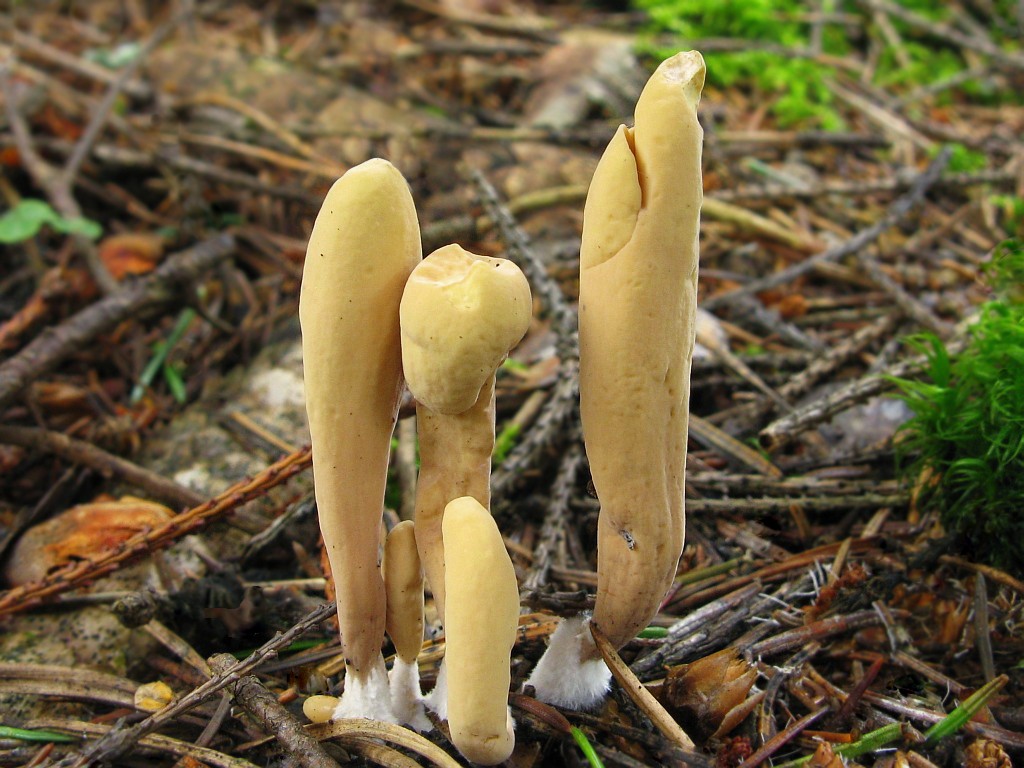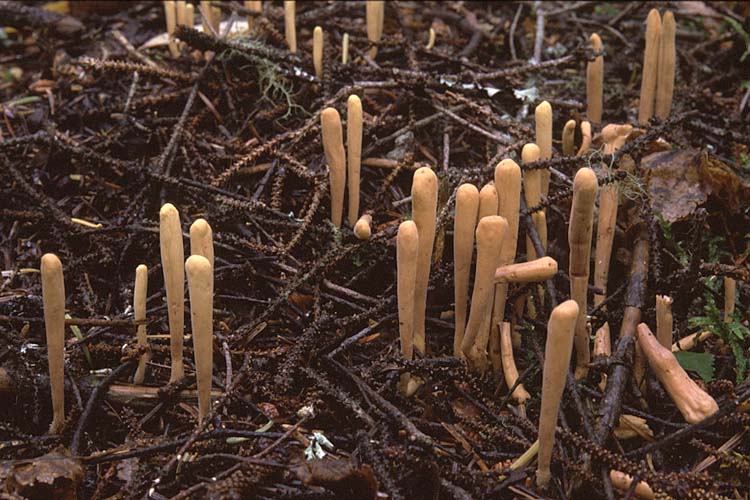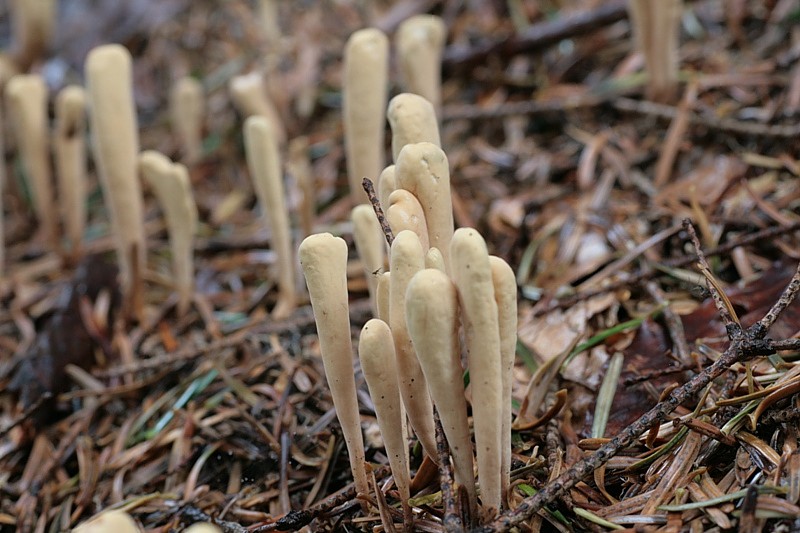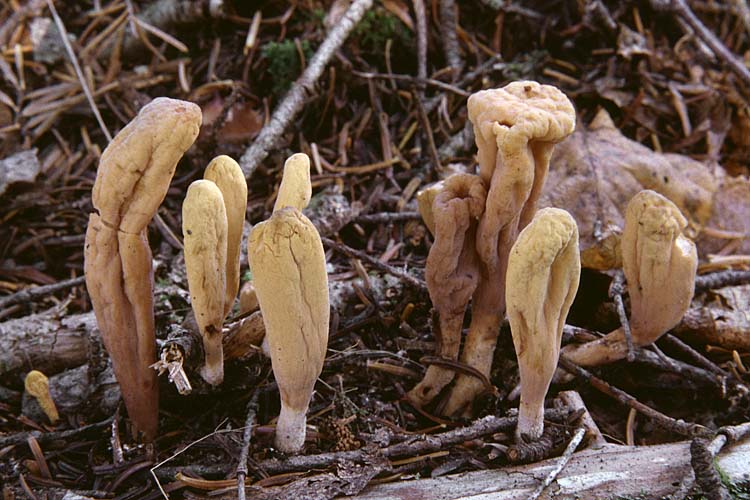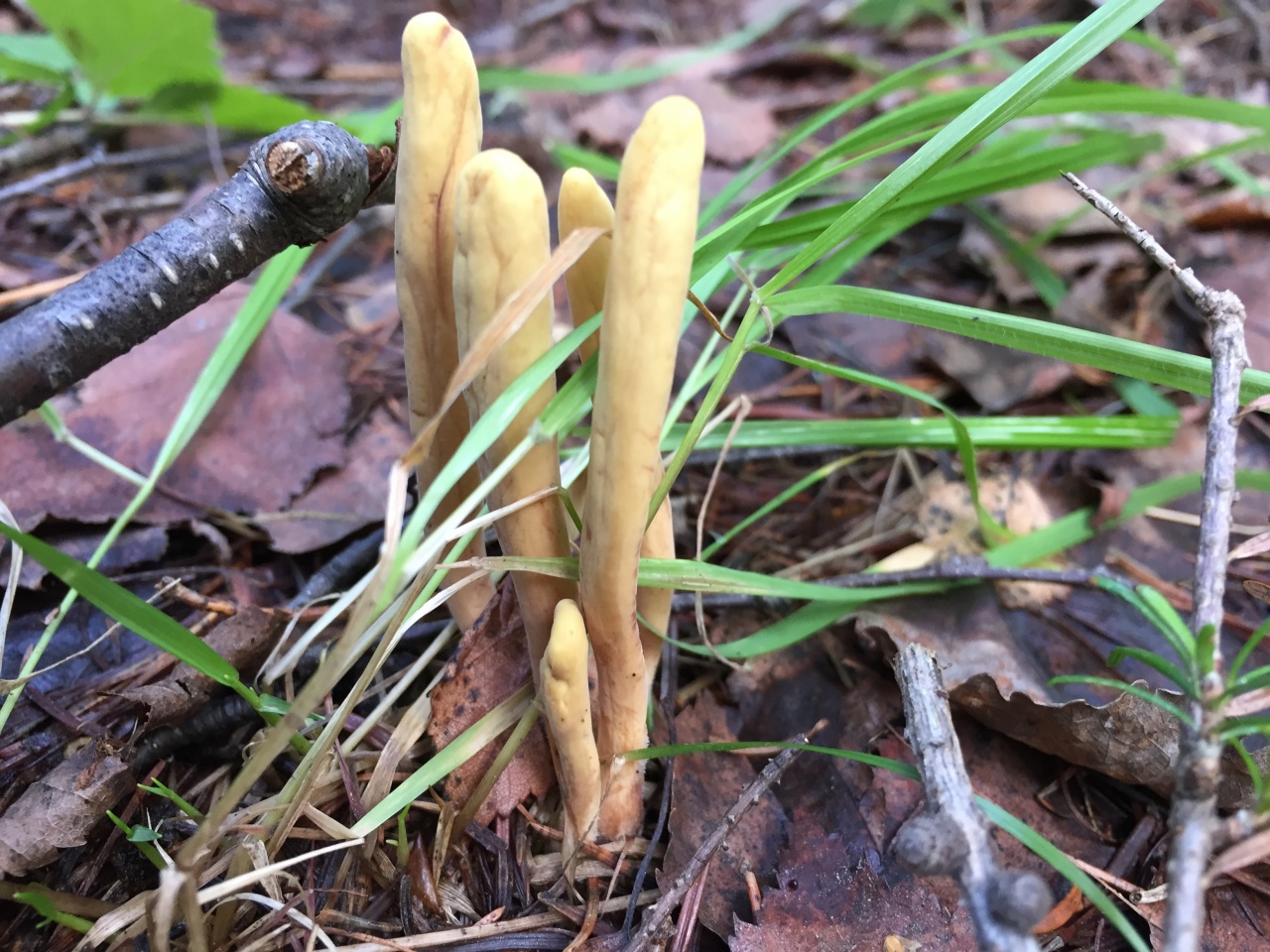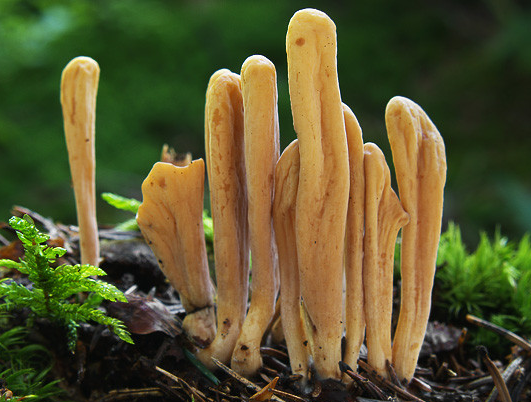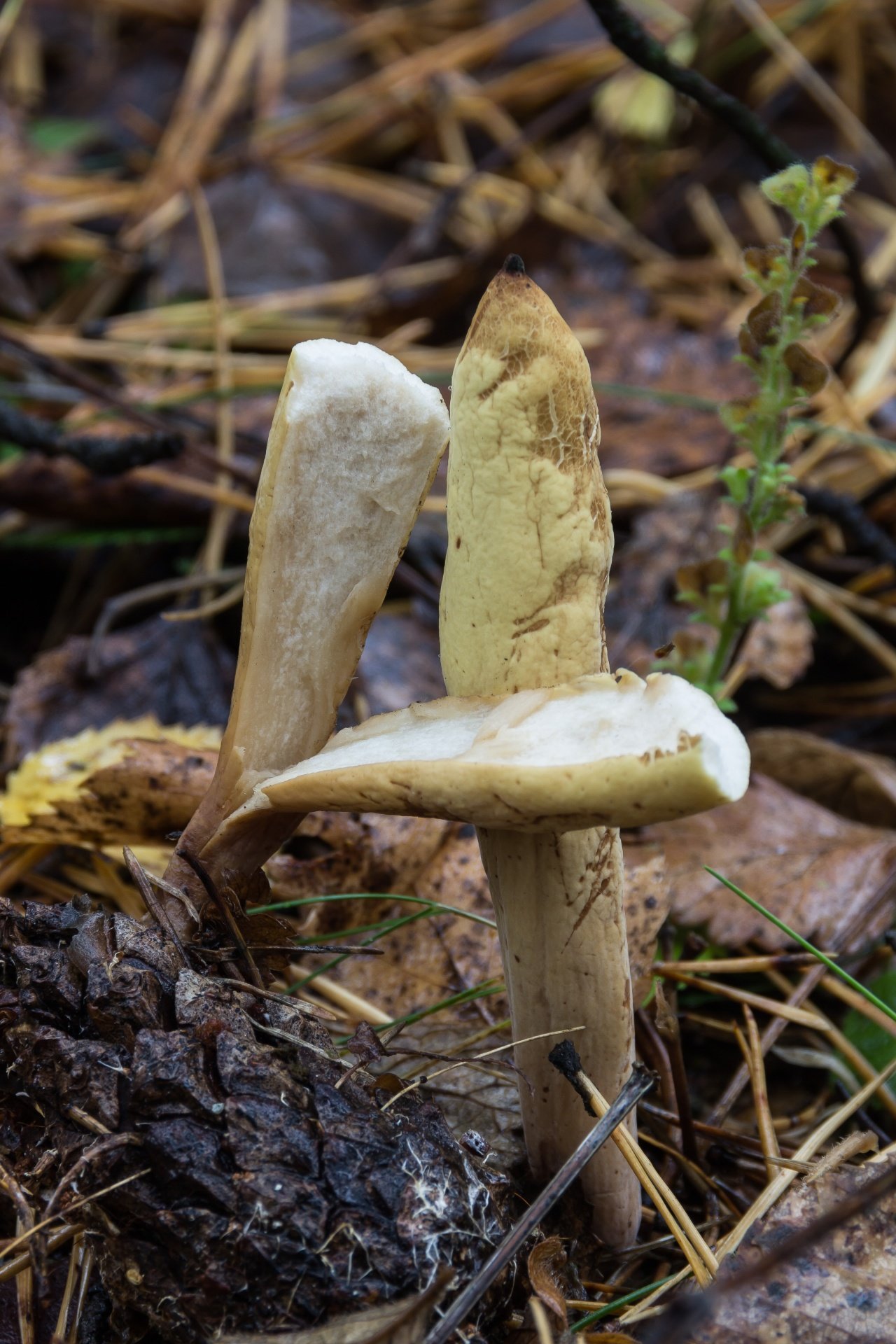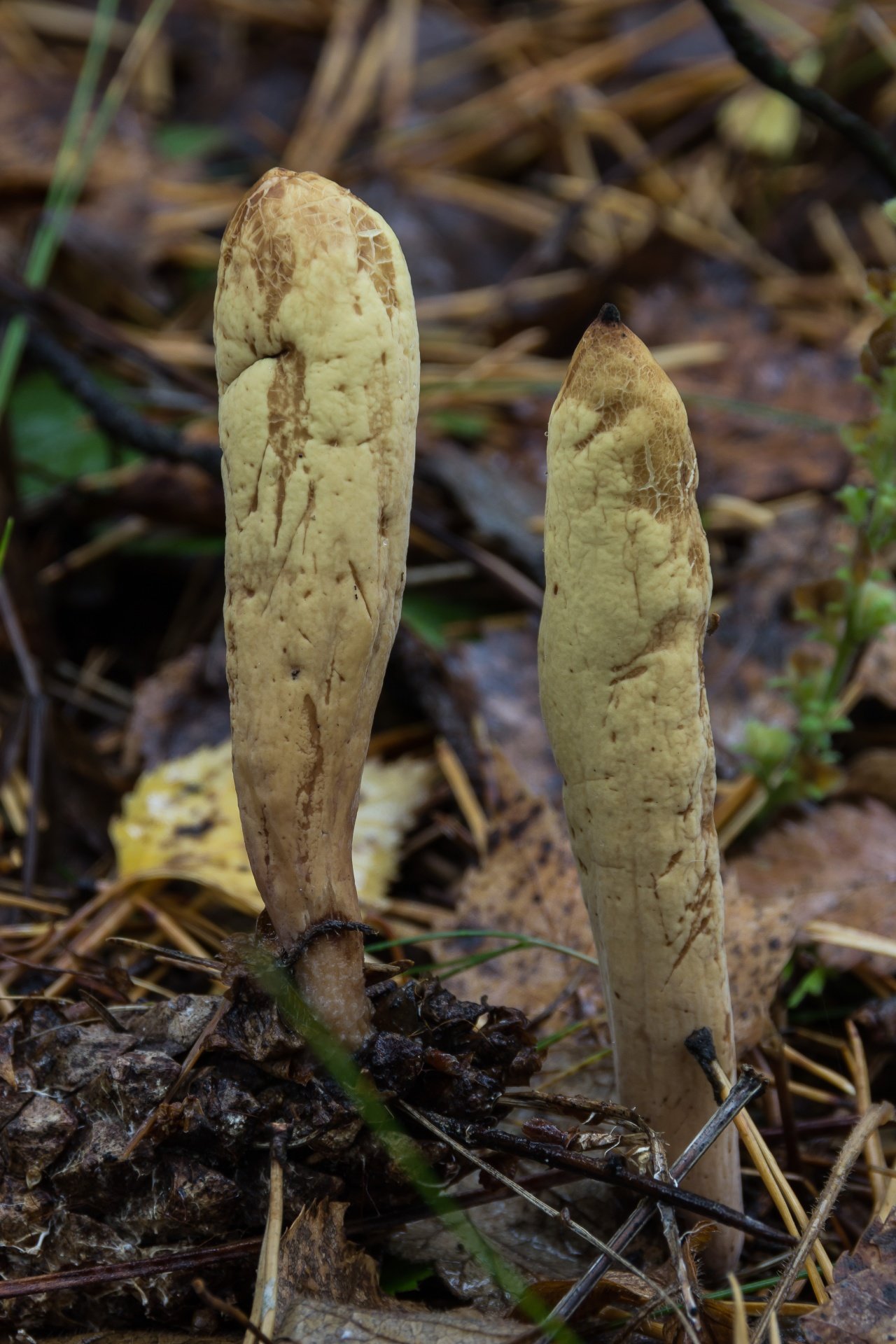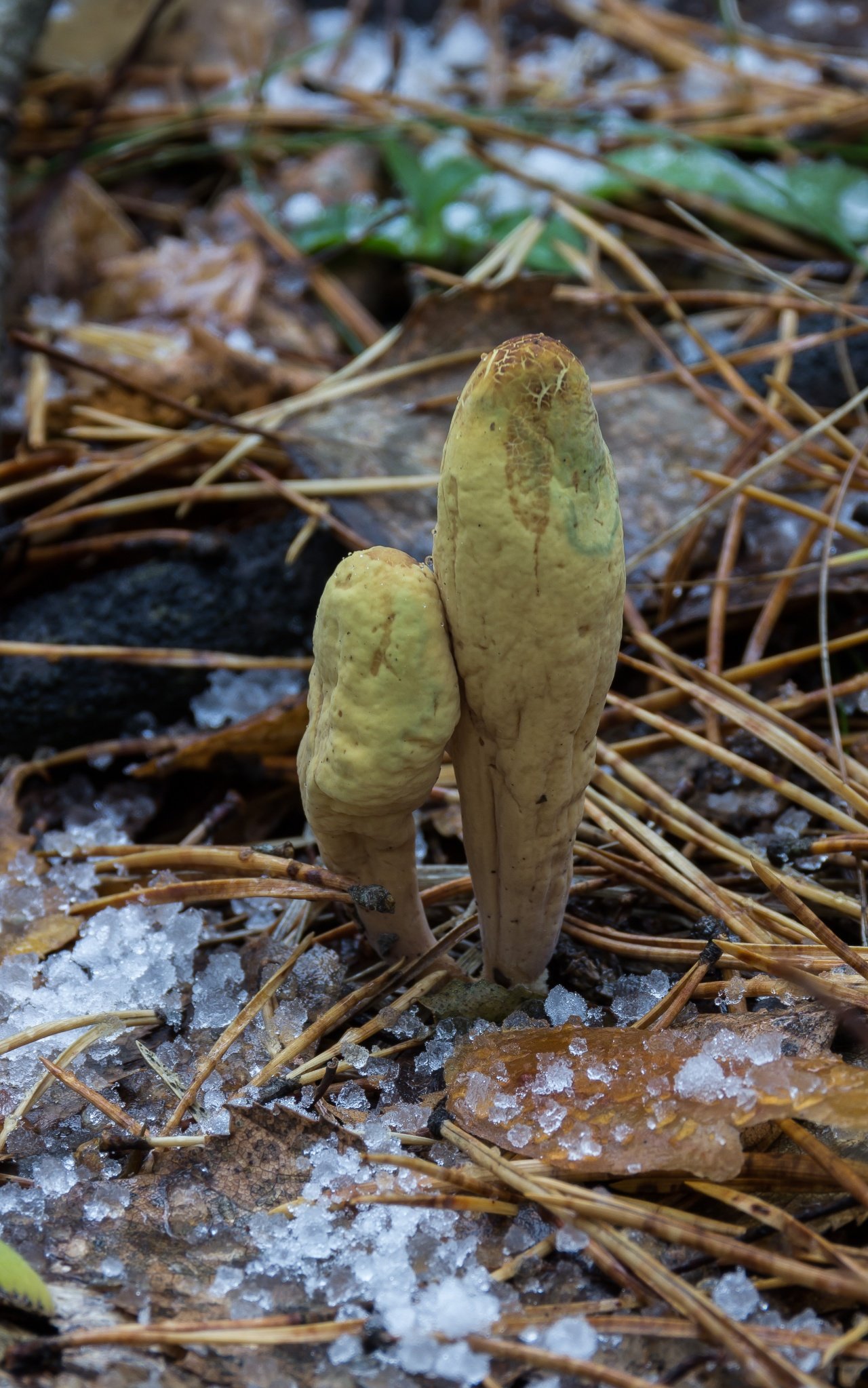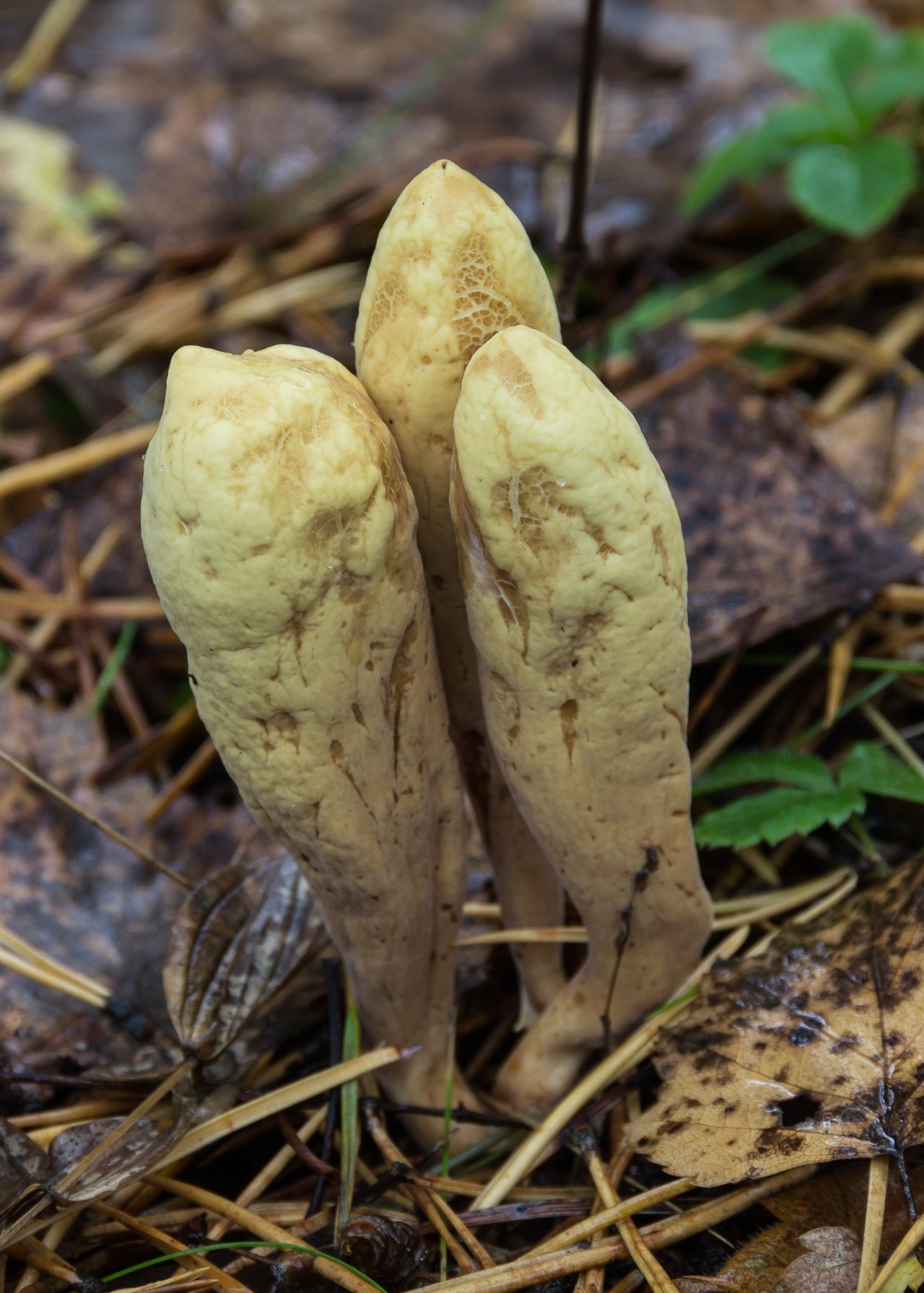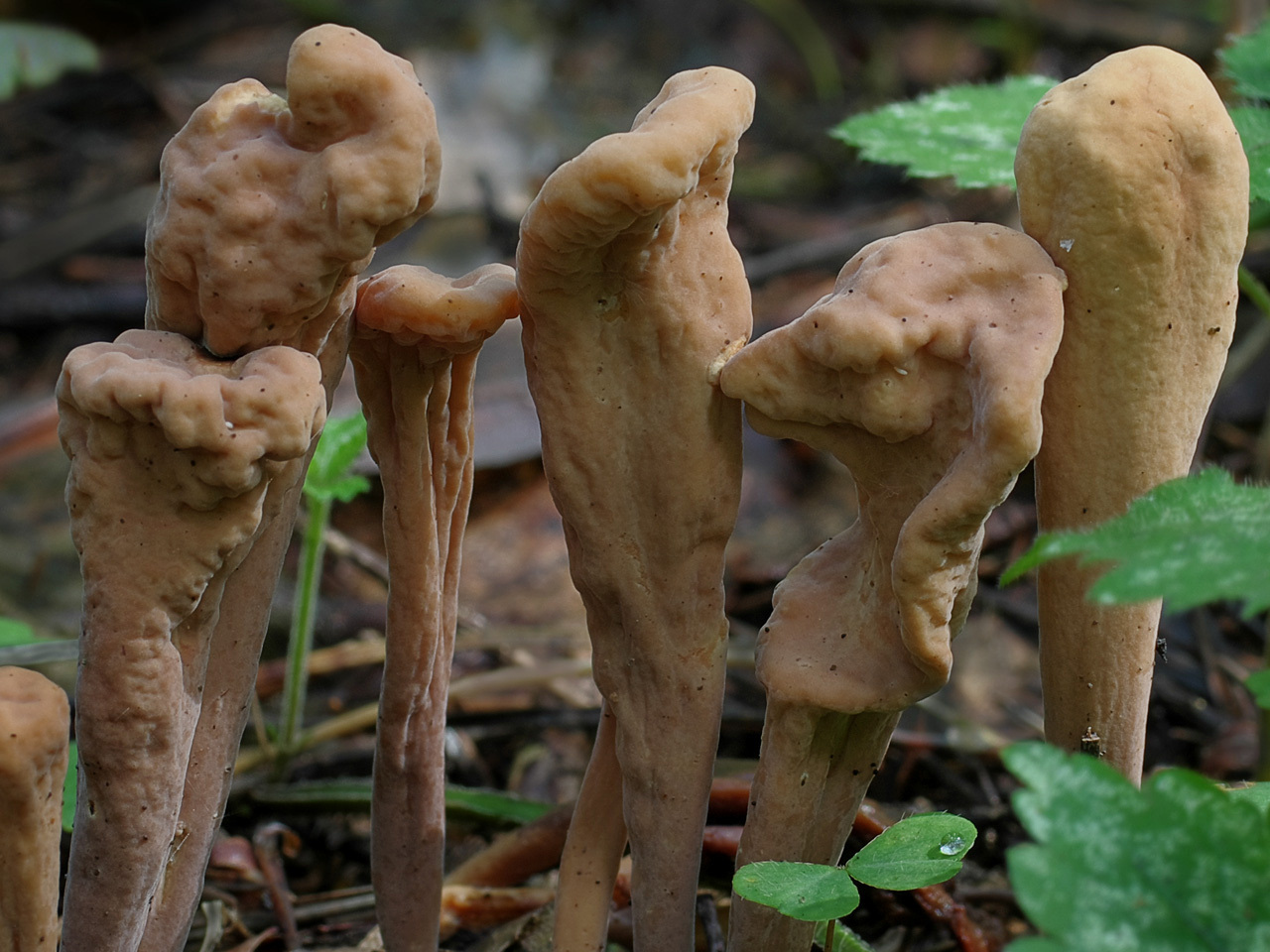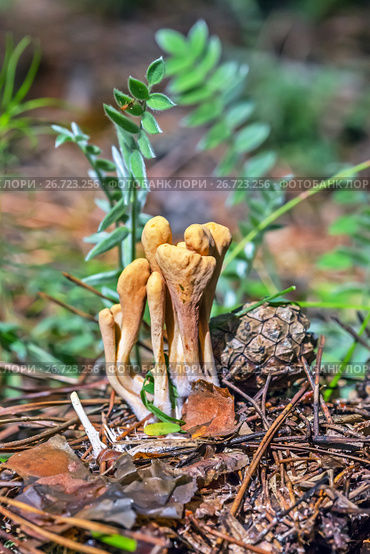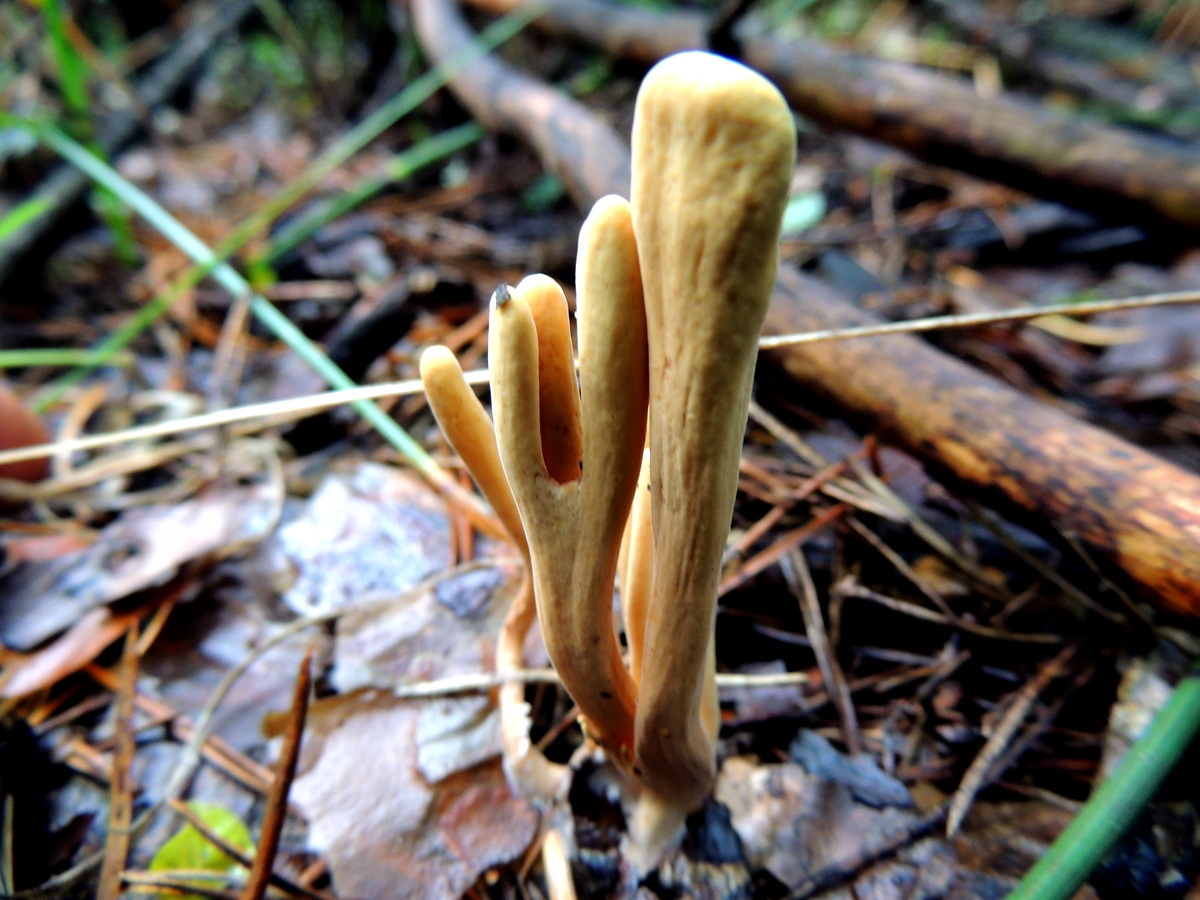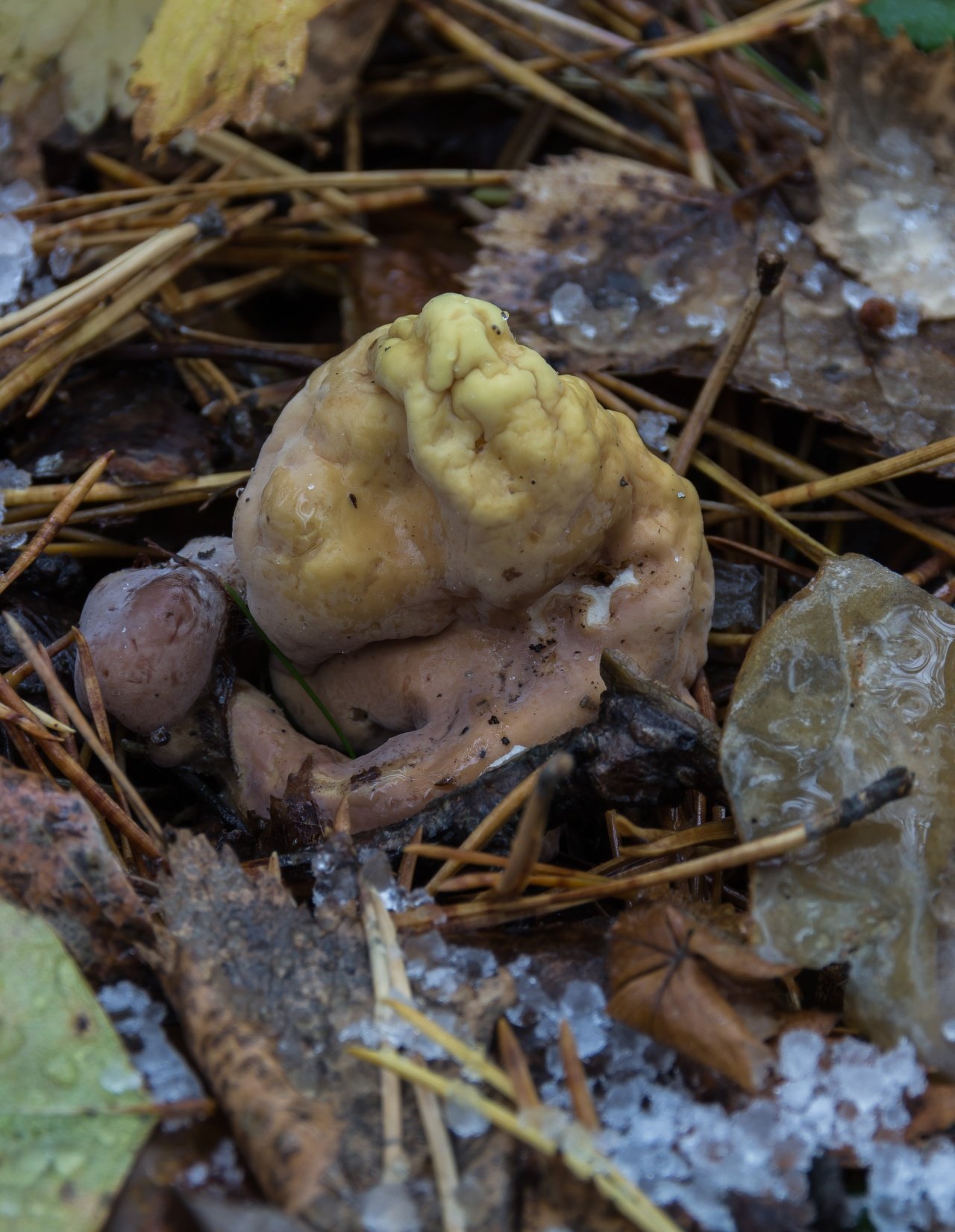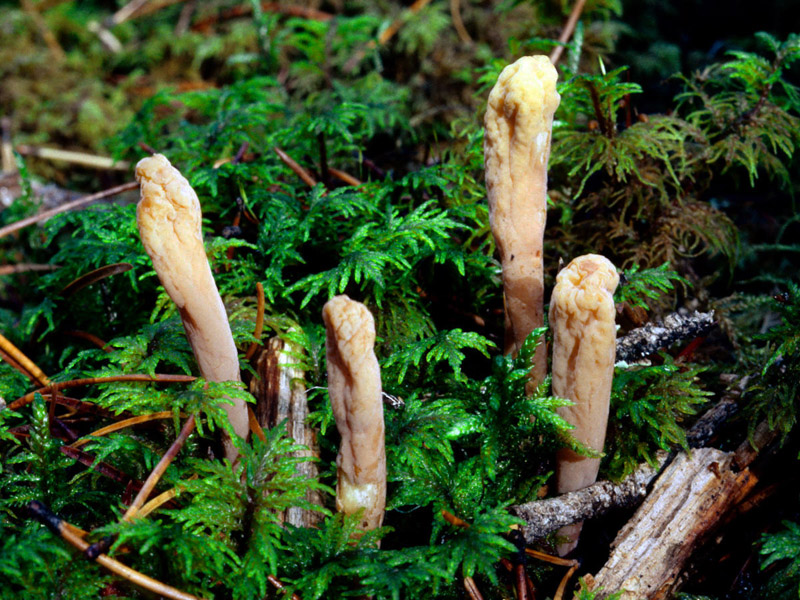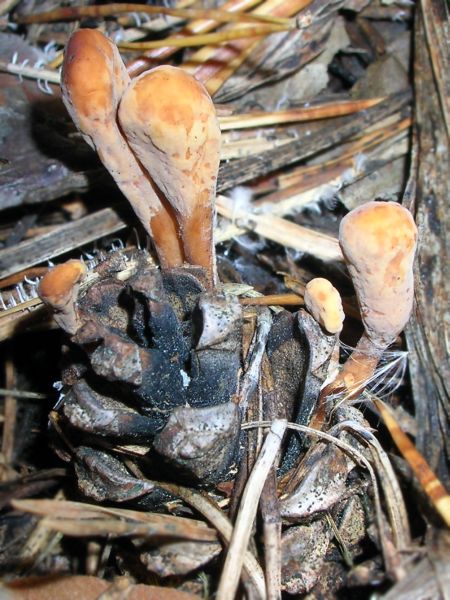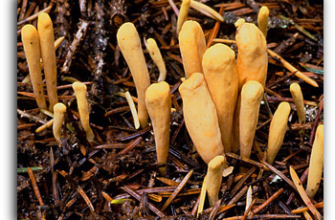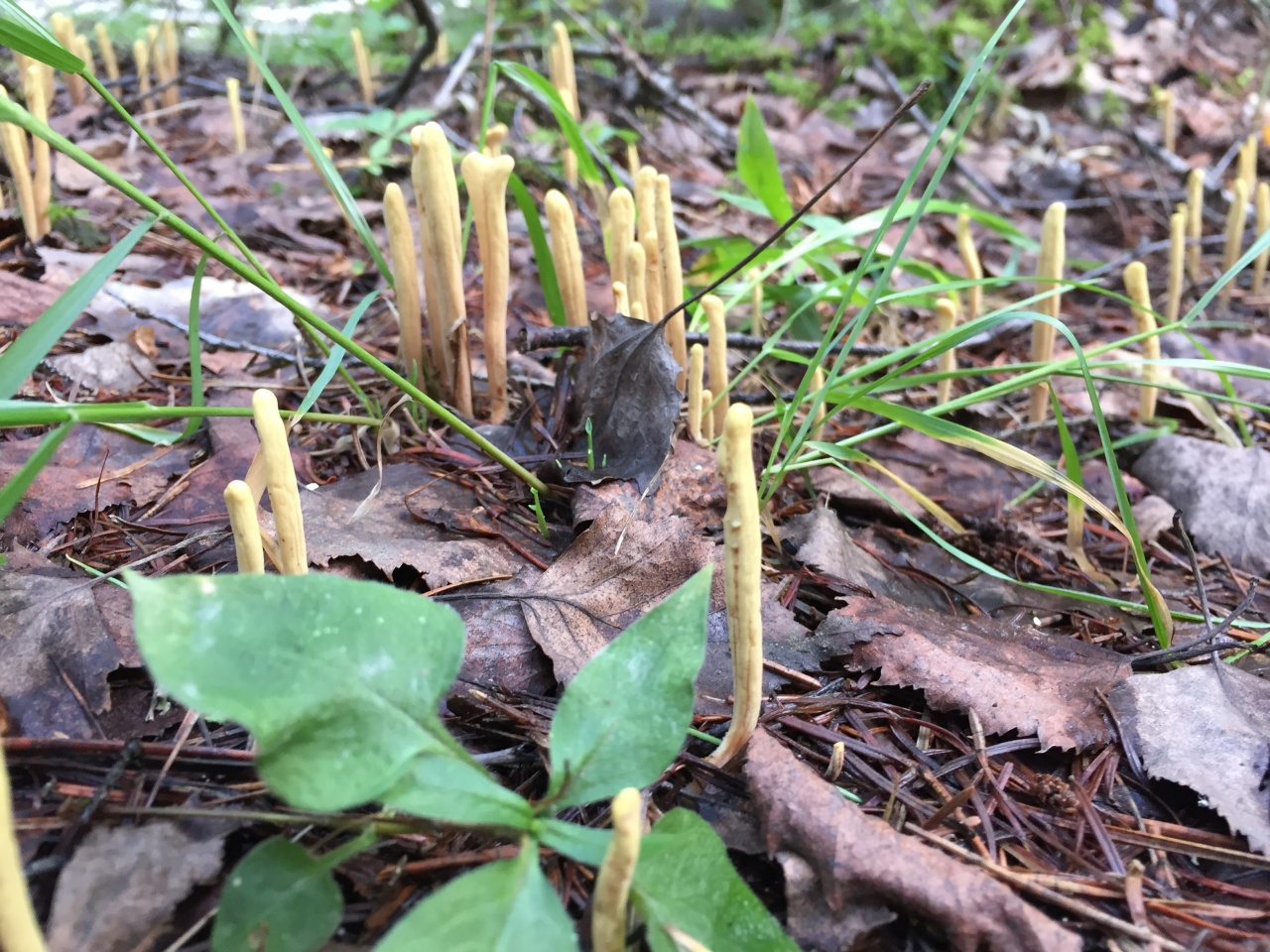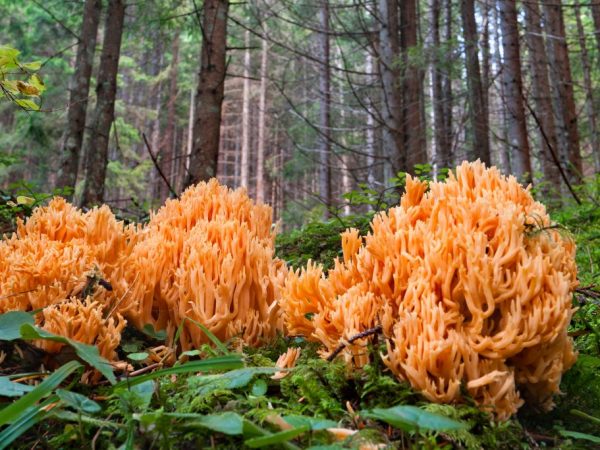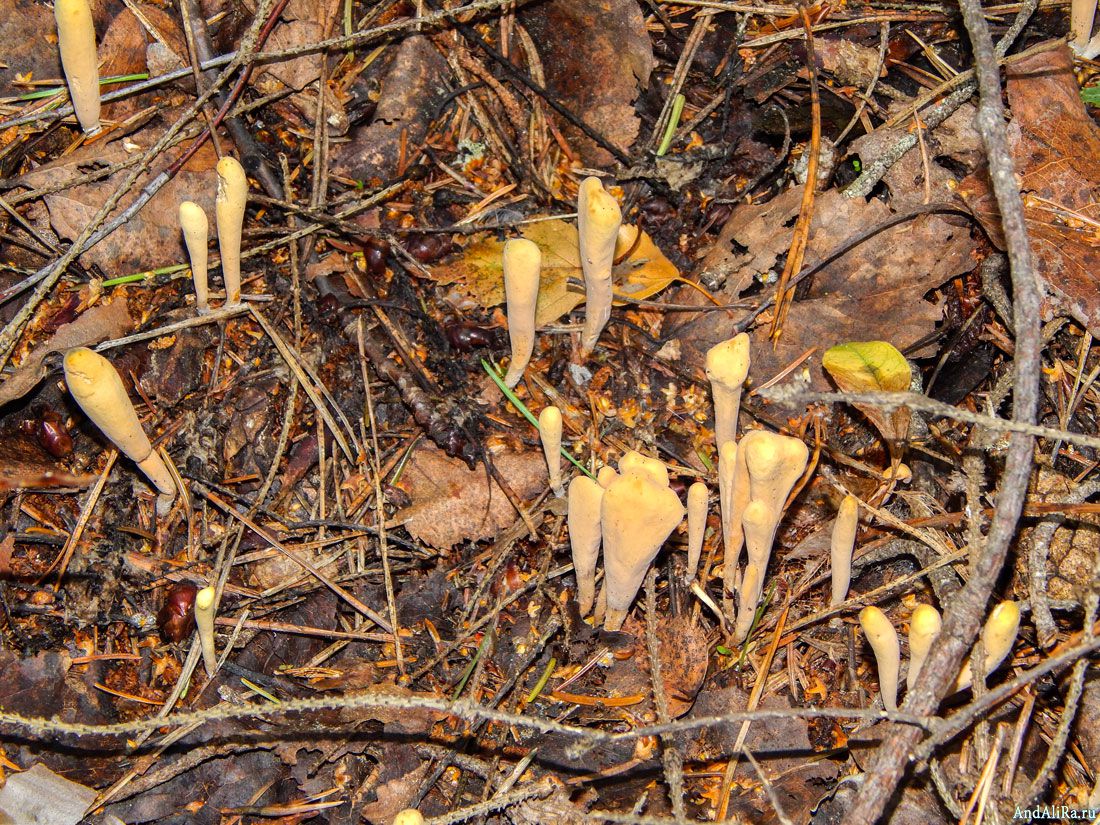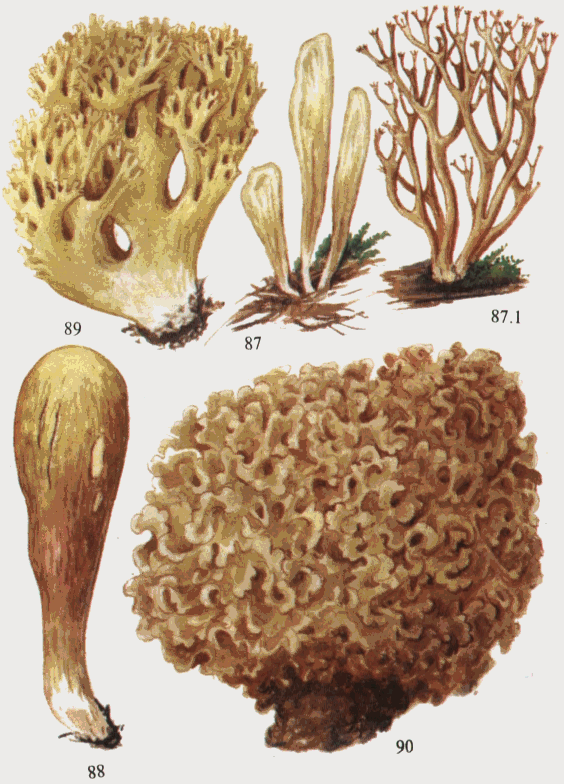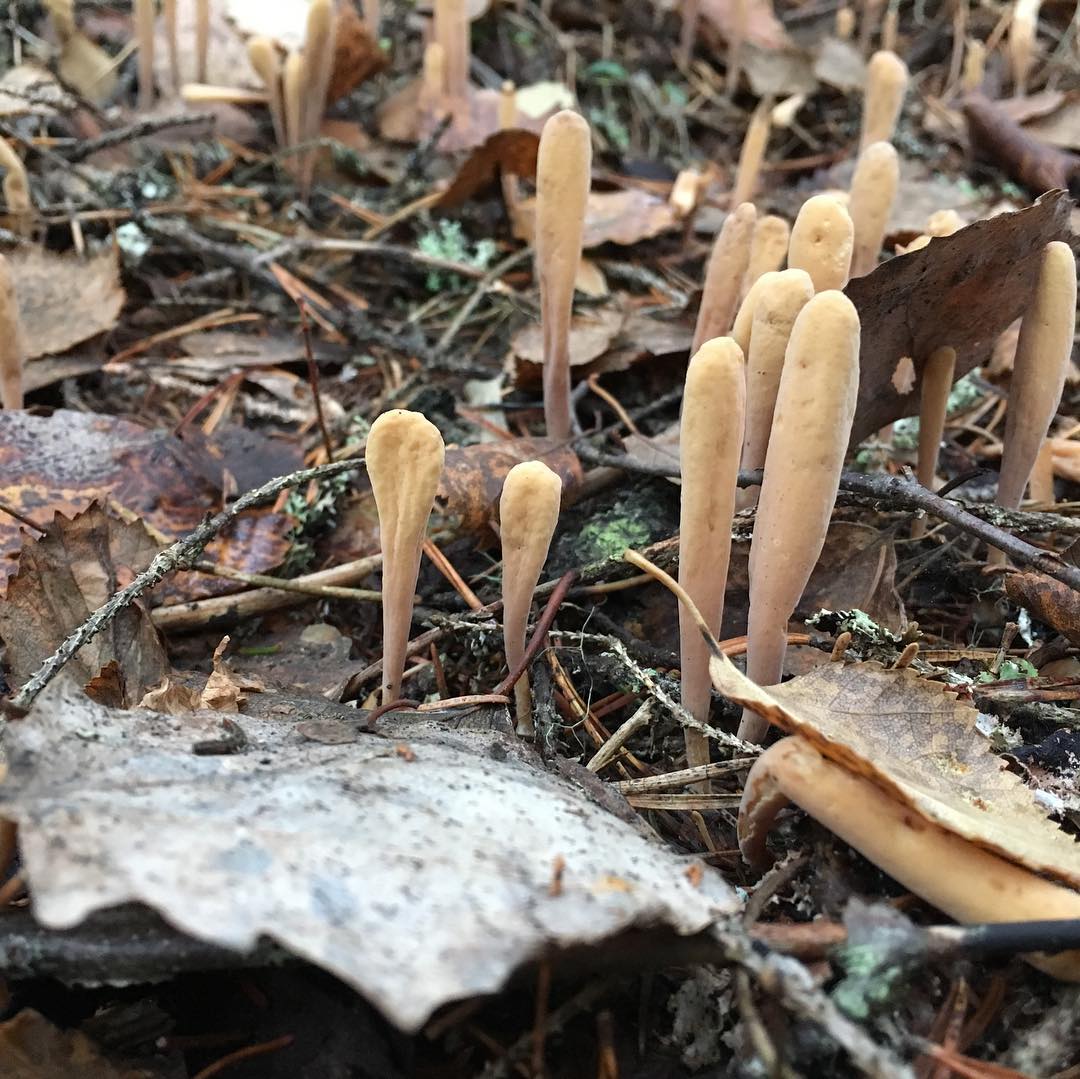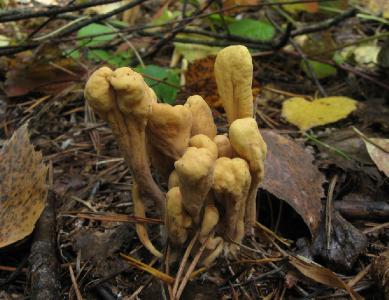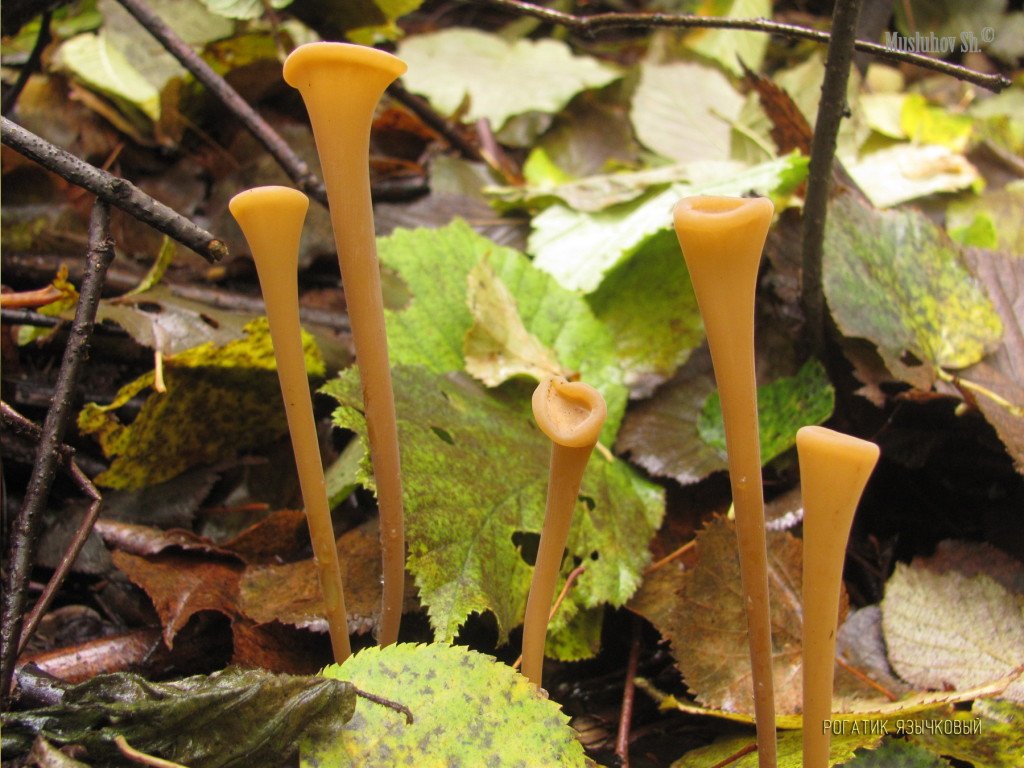A variety of slingshots
This mushroom has a large variety. Let's consider the most common of them and their description.
Pistil species. Can be found in deciduous forests in the southern regions. Has a fruiting club-shaped body. The height can reach 15 cm. The isolated spores are white. Has no specific smell. Completely edible.
Truncated - a bright representative of basidiomycete plants. It has a clavate shape with an expanded and thickened apex. Height is not more than 14 cm. The mushroom itself is wrinkled and dark orange in color. In places of damage, it instantly darkens. Odorless, sweetish in taste.
Reed. Belongs to the genus Claviadelfus. The form is vertical lingual. Height no more than 13 cm. Has a smooth and dry surface. If it is already old, then the surface of the body begins to wrinkle. The color is pale cream, but with age it acquires a yellowish tint. The pulp is dry, white in color and without a characteristic odor. It produces a light yellow spore powder.
Comb-shaped. Coral shape. Grows up to 10 cm in height. The pulp is quite fragile and light. It does not have a specific smell, but it tastes bitter. It can be found in mixed, coniferous and deciduous forests. Germinate in soil and grass.
Fawn belongs to the krallovid family. It grows in the form of a bush with branched branches with pointed branches. The apex is lobed-flat. Horny white with a cream shade. Highlights white spores. When cut, it is fragile, has no special smell and has a bitter aftertaste.
The yellow horned mushroom can be found in deciduous, coniferous or mixed forests. It mainly grows in the forests of Karelia. The body color is yellow. No more than 18 cm in height. Many branched, dense bushy cylindrical branches grow from thick white stumps. The fruit body is yellowish. The pulp is moist and off-white. It smells like grass, the taste is dull. The older the plant, the more bitter the taste.
Reed horn
And here is another horned mushroom. In front of you is a reed horn, or Clavariadelphus ligula.

Reed horn
The pale yellow or creamy fruiting bodies of this fungus are not branched. They are cylindrical in shape, thinner at the stem, with a widened upper part. And most of all they really resemble some tongues sticking out of the ground. The horned reed grows in green moss spruce forests. Fruiting bodies rarely appear alone, more often in groups. Real "witch circles" can also form.
They are small in size - no more than 10 centimeters in height and about a centimeter (rarely more) in diameter, in the upper, expanded part. They appear in the forest in late summer - early autumn.
The reed horncat is one of the important saprotrophs that transform forest litter into humus. And here is a largely mysterious natural "chemical laboratory". And it produces not only fertilizers! And what else? But after all, clavariadelphus, like ramaria, has been little studied so far ...
The mushroom is edible too. Although its quality is not high (4th category), and its taste is not great.
Horned mushrooms are very curious representatives of the mushroom kingdom. In the life of the forest, their role is quite important. And their rather close relationship with chanterelles suggests that, possibly, in a person's life, in strengthening his health, these mushrooms can still play a rather important role.
In the end, after all, a person also first received such an important drug as antibiotics from mushrooms!
I wish you a great mood and more positive emotions that extend your life!
P.S
I look forward to your comment - the reader's opinion is always important to the person who writes!
Places of growth of reed claviadelfus.
Reed horns bear fruit from July to September. They grow in coniferous and mixed forests.Probably, they form mycorrhiza with mosses, because they settle among them. Reed horns are found infrequently, but they come across in large clusters.

Evaluation of the edibility of reed claviadelfus.
Reed horned is considered an edible mushroom, but it does not have mass popularity, but the Germans, Czechs and Bulgarians cook them soups and main dishes. The big plus of horned animals is that they are almost never wormy, forest insects do not start in their fruiting bodies.
Similar species.
The reed horny differs from the representatives of the genus Cordyceps in its beige-yellow color. Poisonous counterparts in reed horns do not exist, so they can be safely collected.

The pistil horned is a related species of the reed horn, which has an external resemblance to it. The pistil horned differs in larger sizes and a pronounced form of a pistil or mace. The surface of the fungus is longitudinally wrinkled. The color is reddish or light yellow, and the base is felt. The pulp is spongy, does not have a special smell. The color of the pulp is light, but it becomes brown on the cut.

Horned pistils are rare mushrooms, they are listed in the Red Book of the Russian Federation. This is a little known species. Fruiting occurs from August to September. Representatives of the genus are found most often in deciduous forests. They prefer more southern regions. This is a conditionally edible type of mushroom.
Hornbeam is another similar relative of the reed horn, but it is distinguished by a very thin, almost acicular fruiting body with a rounded apex. The inside of the mushroom is hollow, and the outside is wrinkled. The coloration of the horned hornbeam is yellow-ocher at first, and later becomes yellow-brown. Its pulp is dense, firm, creamy. Her smell is pleasant or not at all.

Hornbeam can be eaten, it is conditionally edible. Fruiting occurs from September to October. The habitats are mixed and deciduous forests and grassy lawns. Horned hornets settle in colonies and groups, but you can rarely meet them.
Description
In science, this one is called Hericium coralloides (Horny or Ramaria). It belongs to the 4th edible group, the higher class. These are basidiomecetes, which are popularly called hedgehogs, forest corals, deer horns or horns.
Horned mushrooms have the following description:
- erect rod-shaped, branched in shape;
- the color is often white, gray, yellow or cream;
- diameter - from 16 to 30 cm;
- height - up to 25 mm;
- bitter taste;
- the aroma is unpleasant, pungent;
- weight - up to 1 kg.
The surface color changes with the age of the fungus. The old reed horn becomes amethyst or orange.
Beautiful and unusual to the eye, horned mushrooms are listed in the Red Book of Russia. They inhabit shaded thickets on decayed foliage or rotten fallen tree trunks. The ramaria mushroom loves wet places, the period of its active growth is from mid-summer to the end of October.
The reed hornworm does not infect worms, the only pest is the wireworm.
It is easy to grow such "corals" at home using conventional technology.
Views
These organisms are divided into edible and inedible. There are no horns dangerous to human life and health. For a mushroom picker, edible horned mushrooms are a real find if you know how to cook them correctly. These mushrooms are relatives of chanterelles.
Edible species include:
- golden;
- amethyst;
- aciniform;
- yellow;
- truncated;
- reed.
Inedible species:
- fusiform;
- comb;
- pale yellow;
- purple;
- pistillate
- fistful;
- straight.
Edible baby horned mushrooms are pleasantly scented and easy to cook. Most often they give a large harvest.
Reed horn
Horned animals begin to collect at the end of summer
The reed horn (Clavariadelphus ligula) is an edible species with a pale yellow tint. It belongs to saprophytes of the 4th category of edibility.
Its branches are in the form of a cylinder, thin, widened at the bottom.The appearance resembles a human tongue sticking out of the ground, hence the name. The reed horned grows in coniferous forests in whole groups in the form of circles, which the foresters call witch.
Their size is small, up to 10 cm in height. The collection begins at the end of summer.
Ramaria
Forest corals - this is the name of ramaria, which grows in pine forests. Its trunk is incredibly beautiful and looks like a branchy marine organism that accidentally got into the forest thicket. The appearance of ramaria is characterized by:
- dichotomous trunk;
- white color of the inner layer;
- hymenial surface (having spores);
- yellow.
With age, ramaria changes color to orange-red. It is believed that chanterelles and horned ones have common ancestors, so they have a certain similarity in structure.
Ramaria forms mycosis with spruce and pine. It can be eaten, but it has a bitter taste, so it should be harvested at the end of August and September, since young ramaria tastes less bitter.
Beautiful horned
It is a poisonous mushroom that grows in deciduous and mixed forests. It is characterized by:
- height - 20 cm;
- diameter - 18-20 cm;
- short, thick and dense leg;
- bright pink color in young organisms.
Old ramarias become whitish, branch strongly at the bottom, the tips of the branches first turn yellow, and then brown or brown.
Eating food leads to disruption of the gastrointestinal tract.
Comb slingshot
An inedible forest organism that bears fruit in conifers, deciduous and mixed forests from the second half of July to the end of October. Grows in groups of bushes. It has a comb-like shape and a cream or white body color, at the base of which there is a thick, dense leg.
The pulp has a characteristic bitterness. She is fragile and delicate, without a bright aroma.
Let's go to rest together
If you are going to go to rest in these places for mushrooms or fishing or just sunbathe, then invite like-minded people to your company, it is more interesting to relax together.
All posted ads can be viewed in the Travel Book
Alekseevsky forest
A small group of friends | Going to a famous place looking for a company | There are places in the car | We are going to the woods for Alekseevka, today. To see what there is now from the mushrooms, we will stop by the Silver Spring. Join whoever wishes.
Other offers:
Country club "Berezina Rechka"
Fishing club "Forelyandiya"
Recreation center "Polyanka"
Recreation center "Rose of the Winds"
Fishing base "Dolina"
Country club "Atmosphere"
Country club "Luck"
Recreation center "Laguna"
Recreation center "Golden Trout"
Hunting farm "Bolshaya Tavolozhka"
Recreation center "Domostroitel"
Fishing club "Forest Fairy Tale"
Recreation center "Hare ears"
Recreation center Chardym-Dubrava
Fishing base "Volzhsky Bereg"
Recreation center "Izbushka"
Recreation center "Razdolye"
Recreation center "Manor" Mountain air "
Recreation center "Ivolga"
Fishing "On Kalinikhe"
Vershinins' trout farm
Recreation center "Sunflower"
Fishing bases and clubs of the Saratov region
Recreation center "Prirechnoye"
Recreation center "Metalist"
Tourist Saratov, 2018-2020. All rights reserved.
Edible mushrooms
Reed horn (lat.Clavariadelphus ligula) is an edible mushroom from the genus Clavariadelphus. This mushroom is also called truncated horned, claviadelfus reed, mace and hind tongue. The fungus is noticeable, the fruiting body is club-shaped, not branching, colored in orange-yellow or cream tones. Butterflies prefer to grow only in coniferous forests, and they settle exclusively under pine trees in mosses, possibly forming mycorrhiza with them. You can find them on the edges, near stumps and tree trunks. Reed horns grow in the litter, in moss, on the remains of wood buried in the soil and in densely fallen needles. Butterflies bear fruit in groups, sometimes huge, meeting in hundreds or more specimens. Fruiting is observed from July to November, while active growth occurs in October.It comes across infrequently, but in large groups.
The mushroom is considered edible, 4th category, with low palatability. Massively these mushrooms are not harvested anywhere, it is not clear what to do with it. Polysaccharides were isolated from the mycelium culture of horned beetles, which stop the growth of Ehrlich's carcinoma and sarcoma-180 by 90%. The mushroom contains melatonin, a serotonin precursor and hydroxytryptophan. These mushrooms are natural antibiotics.
The fruiting body of the reed stalk has neither a leg nor a cap, is vertical, lingual, somewhat widened in the upper part (sometimes up to the shape of a pistil), often slightly flattened; height 7-12 cm, thickness 1-3 cm (in the widest part). The surface of the fruiting body is smooth at first, later becomes uneven, wrinkled. The inside of the mushroom is hollow.
Its base is fleecy-felt. The color of young fruit bodies is cream or yellow, and then becomes ocher-yellow or orange-yellow, old fruit bodies are brown with a purple tint. This shade is most noticeable at the base of the mushroom. The head of the mace is rounded or flattened, its diameter is 0.5-3 centimeters. The head narrows noticeably towards the base. The pulp is light, whitish, dry, without a noticeable odor.
The pulp of the reed stalk at an early age is soft, spongy, tender, elastic, then it becomes dry and brittle. A noticeable purple tint appears at the fracture of the pulp. The pulp does not have a tangible taste and smell, but sometimes it can be bitter. Spore powder is white, light yellow or cream. The spores of this fungus are long, cylindrical in shape.
The reed horn can be confused with other representatives of the genus Clavariadelphus, especially with the more rare (apparently) pistil horned, Clavariadelphus pistillaris. The one is larger and more "pistil" in appearance. From representatives of the genus Cordyceps, a beige-yellow color of fruit chalk can be a good distinguishing feature.
Horned mushroom how to cook. Views
These organisms are divided into edible and inedible. There are no horns dangerous to human life and health. For a mushroom picker, edible horned mushrooms are a real find if you know how to cook them correctly. These mushrooms are relatives of chanterelles.
Edible species include:
- R. golden;
- R. amethyst;
- R. aciniform;
- R. yellow;
- R. truncated;
- R. reed.
Inedible species:
- R. fusiform;
- R. comb;
- R. pale yellow;
- R. purple;
- R. pistillate;
- R. fistful;
- R. straight.
Edible young horned mushrooms are pleasantly scented mushrooms that are easy to cook. Most often they give a large harvest from one "bush".
Reed horn
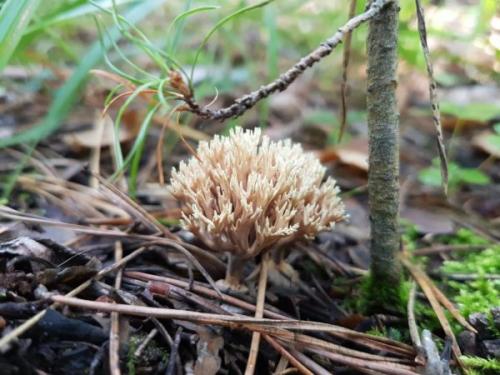
Horned animals begin to collect at the end of summer
The reed horn (Clavariadelphus ligula) is an edible species with a pale yellow tinge in the color of the fruit body. It belongs to saprophytes of the 4th category of edibility.
Its branches are in the form of a cylinder, thin, widened at the bottom. The appearance resembles a human language, as if sticking out of the ground, hence the name. The reed horned grows in coniferous forests in whole groups in the form of circles, which the foresters call "witch".
Their size is small, up to 10 cm in height. The collection begins at the end of summer.
Ramaria ordinary
"Forest corals" - this is also called ramaria, which grows in pine forests. Its "stem" is incredibly beautiful and looks like a real branchy sea coral that accidentally got into the thicket. The appearance of ramaria is characterized by:
- dichotomous "trunk";
- white color of the inner layer;
- hymenial surface (forming and therefore bearing spores);
- yellow.
Irina Selyutina (Biologist):
The ramarias are characterized by the so-called. dichotomous branching of the components of the fruiting body. With this type of branching, the main axis is divided in half at its apex, and each part of it continues to grow until a certain moment and also begins to branch in a similar way. Therefore, a kind of "forks" or, as they say, V or U branches appear.The dichotomous type of branching is considered the most primitive and, accordingly, the most ancient from the point of view of biology.
With age, ramaria changes color to orange-red. It is believed that chanterelles and horned ones have common ancestors, so they have a certain similarity in structure.
Ramaria prefers to grow on litter in coniferous forests. It can be eaten, but it has a bitter taste, so it should be harvested at the end of August and September, since young ramaria tastes less bitter.
Beautiful horned
It is an inedible mushroom that grows in deciduous and mixed forests. It is characterized by:
- height - 20 cm;
- diameter - 18-20 cm;
- short, thick and dense leg;
- bright pink color in young organisms.
Old ramaria become whitish, strongly branching at the bottom, the tips of the “branches” first turn yellow, and then brown or brown.
Eating can lead to slight disruption of the gastrointestinal tract due to the characteristic bitter taste.
Crested hornbeam
An inedible forest organism that bears fruit in conifers, deciduous and mixed forests from the second half of July to the end of October. Grows in groups resembling bushes. It has a comb-like shape and a cream or white body color, at the base of which there is a thick, dense leg.
The pulp has a characteristic bitterness. She is fragile and delicate, without a bright aroma.
Ramaria
The ramaria mushroom, which no longer looks like a mushroom, but some kind of coral, is found most often in coniferous forests, especially in pine forests.
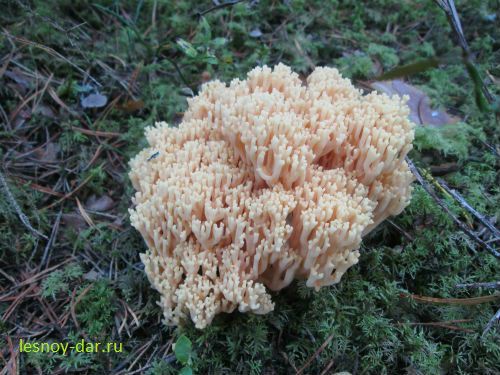
Ramaria
The ramarias do not have the usual division into a leg and a hat. Their fruiting bodies are cylindrical, and branch, as biologists say, dichotomously - this is when a trunk is divided first into two, then each of them is divided into two more, and so on.
The ramaria is painted only on top, its inner layers are white, when pressed, they can turn yellow. Almost the entire surface of the fruiting body is its hymenial layer (i.e., the layer in which spores form).
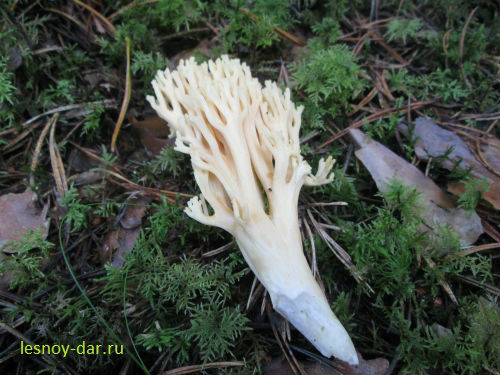
Ramaria fruit body
The young mushroom is yellow, with age its color becomes more intense, and the fruit body is colored orange and even reddish.
In terms of its biological characteristics, ramaria (as well as other horned beetles) is close to chanterelles. However, most mycologists prefer not to talk about the direct relationship of these fungi, claiming that horned, chanterelle, blackberry and agaric mushrooms once had a common ancestor. To which modern slingshots in their structure and some other features are nevertheless closer.
Ramaria is possibly capable of forming mycorrhiza with some trees, in particular with pine and spruce. But even this fact of her life remains unexplored and in many respects mysterious.
Ramaria is considered an edible mushroom of the 4th category. They write that it has a pleasant bitter taste. But only young fruiting bodies should be harvested, a mature mushroom becomes bitter.
However, this is only information taken from the literature (albeit quite serious - for example: "The World of Plants" v.2, - M .: "Education", 1991). I have not tasted ramaria (yes, butter mushrooms, chanterelles, milk mushrooms and other "traditional" mushrooms are quite happy!). Therefore, I do not recommend anything to anyone.
But the mushroom is beautiful! And I think he greatly adorns our forests in August-September, when his bizarre fruiting bodies appear.
Precautionary measures
There are many plants that look like deer legs. Many of them are quite poisonous. Therefore, if you are new to this business, then ask an experienced mushroom picker to tell and show how to correctly collect and distinguish deer legs from other plants.
Remember that after harvesting, before cooking, you must rinse and process them well, because if not cooked correctly, they can have a serious negative effect on your body.
Do not harvest near the pistes, as the plants quickly absorb toxic substances.
The mushroom is considered edible, however, it is not noticed in mass preparations, what to do with it is not clear, but the mushroom is noticeable and you simply cannot pass by.
Let's go together (1)
Reed horn (lat.Clavariadelphus ligula) is an edible mushroom from the genus Clavariadelphus. This mushroom is also called truncated horned, claviadelfus reed, mace and hind tongue. The fungus is noticeable, the fruiting body is club-shaped, not branching, colored in orange-yellow or cream tones. Butterflies prefer to grow only in coniferous forests, and they settle exclusively under pine trees in mosses, possibly forming mycorrhiza with them. You can find them on the edges, near stumps and tree trunks. Reed horns grow in the litter, in moss, on the remains of wood buried in the soil and in densely fallen needles. Butterflies bear fruit in groups, sometimes huge, meeting in hundreds or more specimens. Fruiting is observed from July to November, while active growth occurs in October. It comes across infrequently, but in large groups.
The mushroom is considered edible, 4th category, with low palatability. Massively these mushrooms are not harvested anywhere, it is not clear what to do with it. Polysaccharides were isolated from the mycelium culture of horned beetles, which stop the growth of Ehrlich's carcinoma and sarcoma-180 by 90%. The mushroom contains melatonin, a serotonin precursor and hydroxytryptophan. These mushrooms are natural antibiotics.


The fruiting body of the reed stalk has neither a leg nor a cap, is vertical, lingual, somewhat widened in the upper part (sometimes up to the shape of a pistil), often slightly flattened; height 7-12 cm, thickness 1-3 cm (in the widest part). The surface of the fruiting body is smooth at first, later becomes uneven, wrinkled. The inside of the mushroom is hollow.
Its base is fleecy-felt. The color of young fruit bodies is cream or yellow, and then becomes ocher-yellow or orange-yellow, old fruit bodies are brown with a purple tint. This shade is most noticeable at the base of the mushroom. The head of the mace is rounded or flattened, its diameter is 0.5-3 centimeters. The head narrows noticeably towards the base. The pulp is light, whitish, dry, without a noticeable odor.
The pulp of the reed stalk at an early age is soft, spongy, tender, elastic, then it becomes dry and brittle. A noticeable purple tint appears at the fracture of the pulp. The pulp does not have a tangible taste and smell, but sometimes it can be bitter. Spore powder is white, light yellow or cream. The spores of this fungus are long, cylindrical in shape.
The reed horn can be confused with other representatives of the genus Clavariadelphus, especially with the more rare (apparently) pistil horned, Clavariadelphus pistillaris. The one is larger and more "pistil" in appearance. From representatives of the genus Cordyceps, a beige-yellow color of fruit chalk can be a good distinguishing feature.
Cooking use
Before cooking, you need to properly prepare them. Rinse the mushrooms thoroughly under cold running water. Since they have a sinuous structure, the dirt penetrates into the most difficult places. Then we boil them for 30 minutes. The water in which they were boiled is poured out. It is absolutely impossible to use it. Rinse again under running water and set to cook for 10 minutes. Then we rinse with cold water. Now you can start preparing various dishes.
A simple recipe for a delicious mushroom soup. To begin with, we cut all the vegetables, namely potatoes, onions and carrots (you can add half a Bulgarian pepper). Fill everything with cold water and cook until half cooked. Then add the mushrooms and 15 gr. butter. In winter, add a few cloves of garlic to the soup. As soon as the soup boils, add salt and pepper to taste. Reduce the heat to a minimum and cook for another 15 minutes. The peculiarity of this soup is that it can be eaten not only hot, but also cold. When serving - sprinkle with dill and add a spoonful of sour cream.
For the second, you can simply fry them in addition to the main dish, for example, mashed potatoes or buckwheat porridge. To begin with, fry the onion in vegetable oil, pre-chopping it finely. Add chopped mushrooms. It is better to cut them larger. And fry until golden brown, just remember that you need to stir them constantly. Add salt and pepper to taste.
To make the dishes delicious, we will reveal a few little secrets to you. Firstly, they should be eaten no later than 4 days after harvest. Second, do not pickle or canned them. Otherwise, they will become bitter and rubbery. Thirdly, do not season the mushrooms with a lot of seasonings, otherwise you will kill their unique taste.
The best materials of the month
- Why you can't go on a diet on your own
- How to keep vegetables and fruits fresh: simple tricks
- How to beat your sugar cravings: 7 unexpected foods
- Scientists say youth can be prolonged
Yellow horned (Ramaria flava)
- Other names for the mushroom:
- Ramaria yellow
- Coral yellow
- Deer horns
Other names:
Description
The fruit body of Ramaria is yellow, reaching a height of 15-20 cm and a diameter of 10-15 cm. Numerous branched dense bushy branches with a cylindrical shape grow from a thick white "stump". They often have two blunt tops and improperly truncated ends. The fruit body has all shades of yellow. Under the branches and near the "stump" the color is sulfur-yellow. When pressed, the color changes to wine-brownish. The pulp is wet, off-white, in the "stump" - marbled, does not change color. Outside, the base is white, with a yellowish tinge and reddish spots of various sizes, most often found in fruit bodies growing under coniferous trees. The smell is pleasant, slightly grassy, the taste is weak. The tops of old mushrooms are bitter.
Spore powder ocher yellow.
Habitat and growth time
Horned beetle grows on the ground in deciduous, coniferous and mixed forests in August - September, in groups and singly. It is especially abundant in the forests of Karelia. It is found in the mountains of the Caucasus, as well as in the countries of Central Europe.
Doubles
The hornbeam mushroom is very similar to the golden yellow coral, the differences are noticeable only under a microscope, as well as on Ramaria aurea, which is also edible and has the same properties. At an early age, it has a similarity in appearance and color with Ramaria obtusissima, Ramaria flavobrunnescens is smaller in size.
Note
The word flava in the name of the mushroom means "yellow". Coral mushrooms are considered basidiomycetes. They form spores on the fruit layer, on the outside of the "knots", everywhere. For the most part, coral is good, edible mushrooms, but among them there are also poisonous ones.
This ramaria is considered an edible mushroom, but certain precautions must be taken when eating it. First of all, only young specimens should be collected and the base should be used, since the twigs are bitter
Ripe mushrooms are not edible at all because of the bitterness.
.
Reed horn (Clavariadelphus ligula)
Clavariadelphus reed
The reed horn (lat.Clavariadelphus ligula) is an edible mushroom from the genus Clavariadelphus (lat.Clavariadelphus).
Fruit body: Upright, lingual, slightly widened in the upper part (sometimes up to the shape of a pistil), often slightly flattened; height 7-12 cm, thickness 1-3 cm (in the widest part). The surface of the body is smooth and dry, at the base and in older mushrooms it can be slightly wrinkled, the color in young specimens is soft cream, but with age, as the spores mature (which ripen right on the surface of the fruiting body), it goes into a characteristic yellowness. The pulp is light, whitish, dry, without a noticeable odor.
Spore powder: Light yellow. Distribution: The horned reed occurs from mid-July to the end of September in coniferous or mixed forests, in mosses, possibly forming mycorrhiza with them. It comes across infrequently, but in large groups.
Similar species: The reed horned can be confused with other members of the genus Clavariadelphus, especially with the more rare (apparently) pistil horned, Clavariadelphus pistillaris. The one is larger and more "pistil" in appearance. From representatives of the genus Cordyceps, a beige-yellow color of fruit chalk can be a good distinguishing feature.
Edible: The mushroom is considered edible, but not seen in bulk preparations.
Notes: Mushrooms like horned horns have always puzzled me. What to do with them, how to treat them? Unclear. Pass by, as we pass by a million other unfamiliar mushrooms, does not work: individuality; there is no point in collecting, it is inconvenient to take pictures, because it is vertical. Just walk around and call by name to demonstrate to the forest that they are aware of such matters.
Horned mushrooms, or as they are also called horned mushrooms, belong to the family of basidial plants. They have a fruiting body of a fleshy consistency. They are coral-branched, clavate and subulate. Most often they are white with a yellow tint. Completely covered with a spore-bearing smooth layer.
You can find such a crop in the forest on the soil, less often found on the wood residue. They are not poisonous.
Horned beetles have a large variety and sprout in large numbers, we just sometimes do not pay attention to them. Many mushroom pickers pass by. Maybe this is correct, because unfamiliar plants can be poisonous, but some horned horns are quite edible. Even if you pick such an unfamiliar mushroom, then you will not get poisoned, the only thing is to spoil your dinner, since some species have a specific taste.
The horned is a very curious representative of the mushroom kingdom. It plays a big role in the life of the forest. He is also a close relative of chanterelle mushrooms, and as you know, chanterelles are able to strengthen human health.

